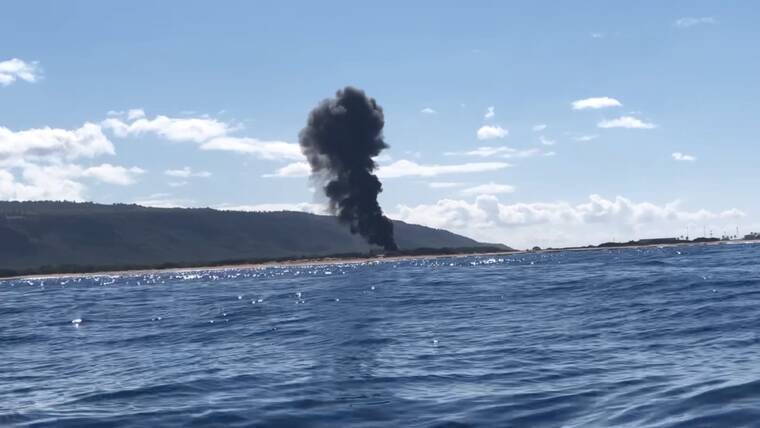NTSB releases preliminary report on Kauai helicopter crash

COURTESY LINDSIE FRATUS-THOMAS
Smoke rose from the site of a fatal helicopter crash at the north end of the Pacific Missile Range Facility on Kauai.
A Sikorsky S-61 N helicopter was approaching a drop-off site as part of a training mission when the aircraft crashed on Kauai Feb. 22, killing all four civilian employees onboard, according to a preliminary report released by the National Transportation Safety Board today.
The report includes information, based on flight tracking data and witness accounts, of the events leading up to the crash that killed pilots Daniel Maurice, 64, and Patrick Rader, 55, and crew members Matthew Haider, 43, and Erika Teves-Valdez, 42.
The crash occurred at about 10:20 a.m. during a training mission that involved locating an inert training torpedo from open waters, retrieving it using a recovery/basket cage system and returning the torpedo by sling load to the Navy’s Pacific Missile Range Facility.
The helicopter, owned and operated by Croman Corp., has provided air support services at the Pacific Missile Range Facility since 2007. The Oregon-based company was under contract with the Navy to retrieve inert training torpedoes from the Pacific Ocean as part of the Navy’s submarine training operations.
NTSB Kekaha Helicopter Cras… by Honolulu Star-Advertiser
Don't miss out on what's happening!
Stay in touch with breaking news, as it happens, conveniently in your email inbox. It's FREE!
The preliminary report said the helicopter was approaching Barking Sands when it crossed the shoreline and began a left turn as it maneuvered to the north and into the prevailing wind. As the aircraft neared the drop-off site, known as the ordnance recovery cage area, the left turn stopped and the helicopter proceeded in a northeasterly direction, based on flight tracking data by the Federal Aviation Administration.
The tracking data stopped recording just before impact.
Multiple witnesses reported that as the helicopter continued the left turn toward the drop-off site, the turn unexpectedly stopped and the aircraft began to travel in a northeast direction. As the helicopter flew in a north easterly direction, about 200 feet above the ground, “it gradually pitched nose down and impacted nose first, in a near vertical altitude.”
A tour boat captain has said he saw the helicopter “erratically” make a sharp turn and went nose down at an accelerated rate.
A final report on the probable cause is expected to be completed in 12 to 24 months.



